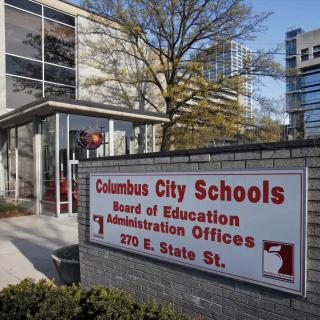Columbus City Council President and Mayoral Candidate Andrew Ginther is seeking to explain away yet another public sector scandal – just as the school data scrubbing scandal he was involved in recedes into the background with the plea bargain of Michael Dodds, the last Columbus City Schools administrator to be charged with a crime. In a new scandal, Karen Findley, an executive of Redflex Corp (the Citys’ red light camera provider) pleaded guilty to conspiracy in federal court in mid-June for bribing Columbus elected officials – including Ginther – to secure the contract in violation of 18 USC 370.
According to the Bill of Information filed by U.S. Attorney, Findley and Redflex did “unlawfully conspire, confederate, and agree together and with each other: to corruptly give, offer, and agree to give, something of value to officials of the City of Columbus, with the intent to influence and reward those agents of the government of the City of Columbus, with the intent to influence and reward those agents in connection with a business, transaction, and series of transactions of $5,000 or more of the City of Columbus, in violation of Title 18, United Stated Code, Section 666y(a)(2),” and to “devise and intend to devise a scheme and artifice to defraud and deprive the citizens of the City of Columbus and the City of Cincinnati of their right to the honest and faithful services of the elected officials of the City of Columbus and the City of Cincinnati, through bribery and the concealment of material information…”
The Bill of Information further continues, stating that “it was an object of the conspiracy for Finley, EXECUTIVE A, and others to enrich themselves and COMPANY A and advance COMPANY A’s business interest by providing campaign contributions to elected public officials in the City of Columbus and the city of Cincinnati in exchange for each elected public official agreeing to take, and thereafter taking, official acts to benefit FINLEY, EXECUTIVE A, COMPANY A, and others… It was an object of the conspiracy to conceal and disguise the true nature and source of the campaign contributions that FINLEY, EXECUTIVE A,COMPANY A, and others provide to elected public officials in the City of Columbus and the City of Cincinnati through CONSULTANT A.”
“The elected public officials received and attempted to receive COMPANY A’S campaign contributions by soliciting CONSULTANT A, who then conveyed these solicitations to FINLEY, EXECUTIVE A, AND COMPANY A. The public officials used CONSULTANT A to apply pressure to COMPANY A concerning the solicitations for campaign contributions. The solicitations from the public officials typically occurred during periods of time when COMPANY A was seeking to obtain and retain municipal contracts.”
“FINLEY, EXECUTIVE A, and others also concealed their activity by using CONSULTANT A to funnel conduit or pass-through campaign contributions from COMPANY A to the elected public officials.
“In return for campaign contributions that the elected public officials received and attempted to receive, the elected public officials agreed to perform, attempted to perform, and actually performed official acts that benefited FINLEY, EXECUTIVE A, AND COMPANY A, including but not limited to the following: (1) obtaining a photo red light enforcement contract with the City of Columbus in or about 2005; (2) extending the contract in or about 2009; (3) modifying, extending, and expanding the contract in or about 2010…”
The Bill details how CONSULTANT A was standing with a Columbus elected official when told a $5,000 check was FedExed on October 22, 2009. The next day CONSULTANT A made a $5,000 contribution to the Franklin County Democratic Party in his own name. Around September 21, 2011, an email from a Columbus campaign discussed a possible $20,000 donation; CONSULTANT A invoiced COMPANY A for a $20,000 “success fee” concerning an extension of the Columbus photo red light program, and Finley signed a MOU to pay a success fee to CONSULTANT A.
Finally on or about October 21, CONSULTANT A contributed $20,000 to the Ohio Democratic Party in his own name, and on or about November 1, 2011, the Ohio Democratic Party made a $21,000 contribution to the campaign of the elected official that had contacted EXECUTIVE A.”
While the Bill of Information does not name names, on October 21, 2011, John Raphael, a registered lobbyist of Redflex, made a $20,000 contribution to the Ohio Democratic Party, and on November 1, 2011, the Ohio Democratic Party made a $21,000 contribution to Andrew Ginther’s campaign PAC “Friends for Ginther.” Raphael and Ginther have been named by other news outlets, as well.
An unbid 2010 contract supported by Ginther and Auditor Hugh Dorrian added cameras and three years to the term of the Redflex contract. At the time Redflex had collected nearly $5 million from Columbus drivers – more than twice as much red light camera fines paid by drivers that was kept by Columbus. At the same time, the modification changed from 38 percent to 45 percent of the percentage of paid citations that were directed to Redflex,while the city’s share dropped going forward.
And one more time within the year, Andrew Ginther was focused on defending his record from allegations related to official wrongdoings.
Ginther hosted a press conference in late June saying he intended “to set the record straight” about an “investigation into illegal activities of Redflex.” Ginther said “initial stories linking me to those acts were flat out wrong... This investigation is not about me, has never been about me, and never will be about me. I never received a contribution from Redflex in 2011. That never happened…”
Of course what Ginther dances around in that statement is that the U.S. Attorney’s charge is not that Ginther received a contribution from Redflex, but that the Ohio Democratic Party receive a contribution from Redflex’s lobbyist and funneled and laundered that investigation was clearly focused on Karen Findley and Ginther’s name came up in that investigation. Also, money from Redflex did not flow directly into the Ginther campaign – as indicated in the Bill of Information – money flowed from John Rafael to the Ohio Democratic Party, and then into Ginther’s PAC.
The irony of Ginther being busted in this bribery allegation is heightened by Ginther’s recent refusal to even consider a campaign finance solution crafted by Columbus citizens that would have addressed these very issues. The Columbus Fair Campaigns Code circulated by the Columbus Coalition for Responsive Government last year would have greatly reduced the incentives and likelihood of the alleged bribes taking place through political campaign donations.
First, the petition had language providing for a public campaign fund for council candidates, so candidates could afford their own elections and would not rely on the council president to raise their campaign dollars for them. (The Coalition had previously analyzed campaign spending and found that Friends for Ginther spent up to 90 percent of the campaign spending for an individual council member (former member Troy Miller in 2011), 84 percent of campaign spending for former member Herschel Craig, 72 percent for current members Michelle Mills and Prisclla Tyson, and 52 and 57 percent for Eileen Paley and Zach Klein. In fact, Ginther’s PAC accounted for a full 70 percent of incumbent Democrat campaign spending during the 2013 election when he was not even on the ballot.
Second, the petition rejected by Ginther’s Council called for use of publicly-owned and operated television stations to air candidate debates and allow candidate programming at a minimal cost – again with a goal of reducing the cost for candidates to communicate with the public. Third, it put a limit of $25 on contributions by registered City lobbyists. Fourth it restricted bundling by lobbyists and capped exchanges of money between PACs and political organizations to $15,000 – meaning the Ohio Democratic Party would not have been able to “launder” Raphael’s $20,000 contribution from RedFlex to Ginther, as is alleged by the US Attorney here and as shows up in Ginther’s campaign finance reports.
Columbus politicians all in bed together to defeat citizen initiatives
Ordinary citizens have been long aware of the weaknesses in Columbus’ system of funding political campaigns and the potential for abuse, and submitted 497 part-petitions totaling nearly 14,200 signatures in 2014 seeking a citizen vote to make those changes. It was City Clerk Angie Blevin in Ginther’s Council that refused to consider the petitions, deferring to City Attorney Rick Pfeiffer who said the certified pre-circulation copy of the petitions should have been filed with the City Auditor, instead of the City Clerk. (This opinion from Pfeiffer came despite city-backed objections to an earlier Coalition petition that were raised by Mayor Coleman and Andrew Ginther’s PAC Treasurer and election lawyer Don McTigue who argued that the pre-circulation petition copy should have been filed with the Clerk and not the Auditor, and Auditor Hugh Dorrian and City Attorney Pfeiffer’s silence on the issue when it was brought before the Franklin County Board of Elections in 2013.)
The Free Press has expressed concern about the increasing secrecy of local government, from the City’s “Open Meetings” ballot initiative that actually closed meetings for the first time ever, the shuttering of community access television and expansion of city government television, and the end of televised public comment on non-agenda items raised by the public at city council meetings among other repressive steps taken by the city to operate with less scrutiny.
Willis Brown, one of the Coalition’s five petition committee members, says, “We have known for a long time that our local government was corrupt and we have said that – but no one listened. Now the federal government has investigated and confirmed what we have been saying – ‘that when all the politicians are in bed together the people get screwed.’ We’ve had to fight the city council, Mayor’s office, City Attorney and City Auditor to try to get common sense solutions to the people, and these same elected officials – in bed together raising and spending money – have, to date, blocked us at every pass.
“We will soon be presenting a charter amendment for a return to council districts – so that council members will not all be beholden to corporations and politicians that fund their campaigns, but so that council members will be accountable to the people they serve. We have had these citywide elections for council members for the last 100 years, and it is time to change back to the ward system we used to have and that the rest of America has. We will continue to monitor the resolution of this corruption in city government, and we are continuing with our effort to structurally fix our government’s failings. This is a government of the people – not of the politicians, and as the people we need to make sure it is not stolen, but it continues to work for us.”
While Andrew Ginther claims to not be the focus of a bribery investigation, an informed source says that he and other Columbus elected officials remain subjects of the federal corruption investigation. The allegations that Ginther was the bribed elected official should spawn a City Council review of member Ginther’s conduct, and whether he violated rules of council or engaged in gross misconduct, malfeasance or misfeasance during his term in office. If the Council finds that he has, the Council has the right and responsibility under Section 9-3 of the city charter to punish or to expel Ginther. If Council passes on its review of its member, then the question for citizens is whether they will look the other way at yet another Ginther public failure, or vote him out of elected office in November or let him ascend to Mayor of Columbus with his record of public failure.



